engine Citroen C4 RHD 2015 2.G Service Manual
[x] Cancel search | Manufacturer: CITROEN, Model Year: 2015, Model line: C4 RHD, Model: Citroen C4 RHD 2015 2.GPages: 328, PDF Size: 12.72 MB
Page 131 of 328

99
129
Anti-theft protection
Electronic engine immobiliser
The
key
contains
an
electronic
chip
which
has
a
special
code.
When
the
ignition
is
switched
on,
this
code
must
be
recognised
for
engine
starting
to
be
authorised.
This
electronic
engine
immobiliser
locks
the
engine
management
system
a
few
minutes
after
the
ignition
is
switched
of
f
and
prevents
starting
of
the
engine
by
anyone
who does not have the key.
In the event of a fault, you
are
informed
by
illu
mina-
tion
of
this
warning
lamp,
an
audible
signal
and
a
message
in
the
screen.
In this case, your vehicle will not start;
contact
a
CITROËN
dealer
as
soon
as
possible. It
has 3 positions:
-
position
1
(Stop):
insert
and
remov
-
ing
the key,
-
position
2 (Ignition on)
:
steering
column
unlocked,
ignition
on,
Diesel
preheating,
engine running,
-
position
3 (Starting).Avoid
attaching
heavy
objects
to
the
key
,
which
would
weigh
down
on
its
blade
in
the
ignition
switch
and
could
cause
a
mal
-
function.
Ignition on position
It
allows
the
use
of
the
vehicle's
elec
-
tric
equipment
or
portable
devices
to
be
charged.
Once
the state of charge of the battery drops
to the reserve level, the system
switches
to
energy
economy
mode:
the
power
supply
is
cut
of
f
automatically
to
preserve
the remaining battery charge.
Keep
safely
,
away
from
your
ve
-
hicle,
the
label
attached
to
the
keys
given
to
you
on
acquisition
of
the vehicle.
STARTING-SWITCHING OFF THE ENGINEIgnition switch
DRIVING
Page 132 of 328
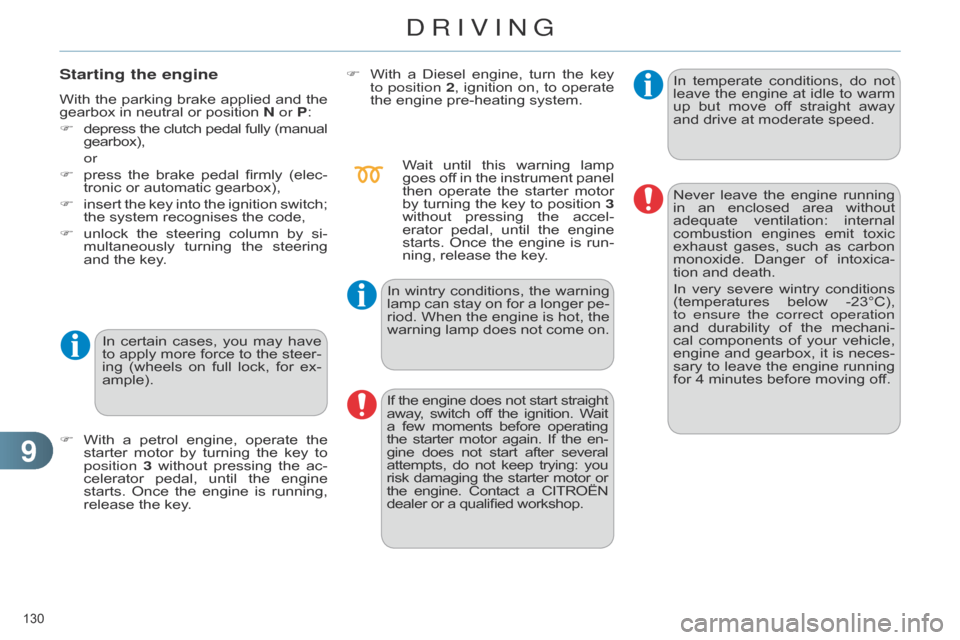
99
130
Starting the engine
With the parking brake applied and the gearbox
in neutral or position N or P:
F
depress
the
clutch
pedal
fully
(manual gearbox),
or
F
press
the
brake
pedal
firmly
(elec
-
tronic
or automatic gearbox),
F
insert
the
key
into
the
ignition
switch;
the
system recognises the code,
F
unlock
the
steering
column
by
si
-
multaneously
turning
the
steering
and
the key.
In
certain
cases,
you
may
have
to
apply more force to the steer-
ing
(wheels
on
full
lock,
for
ex
-
ample).
F
With
a
petrol
engine,
operate
the
starter
motor
by
turning
the
key
to
position 3
without
pressing
the
ac
-
celerator
pedal,
until
the
engine
starts.
Once
the
engine
is
running,
release
the key. F
With
a
Diesel
engine,
turn
the
key
to position
2, ignition on, to operate the
engine pre-heating system.
Wait
until
this
warning
lamp
goes
of
f
in
the
instrument
panel
then
operate
the
starter
motor
by
turning
the
key
to
position 3
without
pressing
the
accel
-
erator
pedal,
until
the
engine
starts.
Once
the
engine
is
run
-
ning,
release the key.
In
wintry
conditions,
the
warning
lamp
can
stay
on
for
a
longer
pe
-
riod.
When
the
engine
is
hot,
the
warning
lamp
does
not
come
on.
If
the engine does not start straight
away
,
switch
of
f
the
ignition.
W
ait
a
few
moments
before
operating the
starter
motor
again.
If
the
en
-
gine
does
not
start
after
several attempts,
do
not
keep
trying:
you risk
damaging
the
starter
motor
or the
engine.
Contact
a
CITROËN dealer
or a qualified workshop.In
temperate
conditions,
do
not
leave
the engine at idle to warm up
but move of f straight away
and
drive at moderate speed.
Never
leave
the
engine
running
in
an
enclosed
area
without
adequate
ventilation:
internal
combustion
engines
emit
toxic
exhaust
gases,
such
as
carbon
monoxide.
Danger
of
intoxica
-
tion
and death.
In
very
severe
wintry
conditions
(temperatures
below
-23°C),
to ensure the correct operation
and
durability
of
the
mechani
-
cal
components
of
your
vehicle,
engine
and
gearbox,
it
is
neces
-
sary
to
leave
the
engine
running
for
4 minutes before moving off.
DRIVING
Page 133 of 328
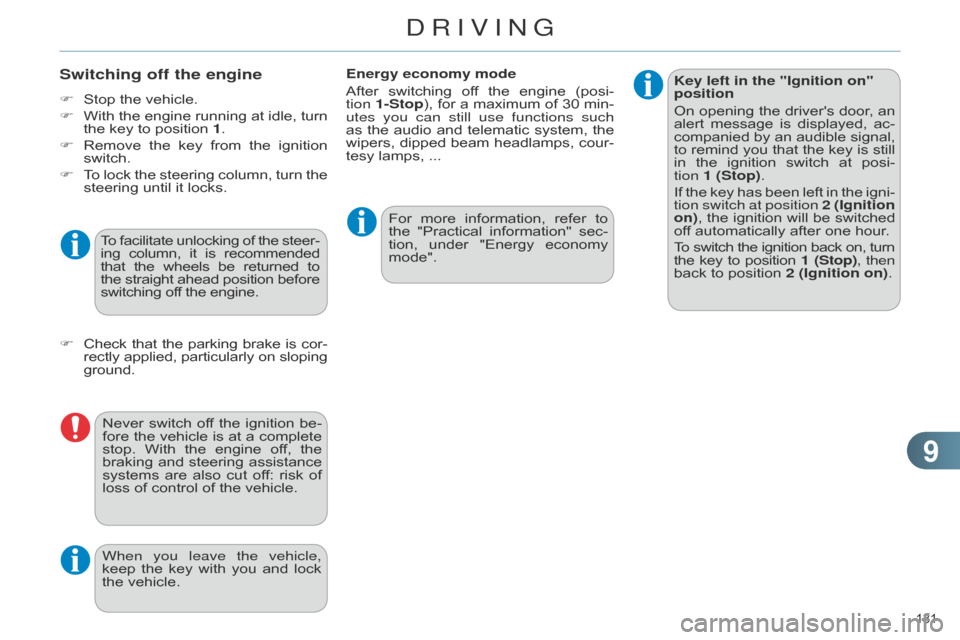
99
131
Key left in the "Ignition on"
position
On
opening
the
driver's
door
,
an
alert
message
is
displayed,
ac
-
companied
by
an
audible
signal,
to
remind
you
that
the
key
is
still
in
the
ignition
switch
at
posi
-
tion
1 (Stop).
If
the
key
has
been
left
in
the
igni
-
tion switch at position 2 (Ignition
on),
the
ignition
will
be
switched
of
f automatically after one hour.
To
switch
the
ignition
back
on,
turn the
key
to
position
1 (Stop)
, then
back
to position 2 (Ignition on).Switching off the engine
F Stop the vehicle.
F
With
the
engine
running
at
idle,
turn
the
key to position 1.
F
Remove
the
key
from
the
ignition
switch.
F
T
o
lock
the
steering
column,
turn
the
steering
until it locks. Energy economy mode
After
switching of f the engine (posi -
tion 1-Stop ), for a maximum of 30 min -
utes you can still use functions such
as
the
audio
and
telematic
system,
the
wipers,
dipped
beam
headlamps,
cour
-
tesy
lamps, ...
For
more
information,
refer
to
the
"Practical
information"
sec
-
tion,
under
"Energy
economy
mode".
T
o
facilitate
unlocking
of
the
steer
-
ing
column,
it
is
recommended that
the
wheels
be
returned
to the
straight
ahead
position
before switching
off the engine.
F
Check
that
the
parking
brake
is
cor
-
rectly
applied,
particularly
on
sloping ground.Never
switch
of
f
the
ignition
be
-
fore
the
vehicle
is
at
a
complete
stop.
With
the
engine
of
f,
the
braking
and
steering
assistance
systems
are
also
cut
of
f:
risk
of
loss
of control of the vehicle.
When you leave the vehicle,
keep
the
key
with
you
and
lock
the
vehicle.
DRIVING
Page 134 of 328
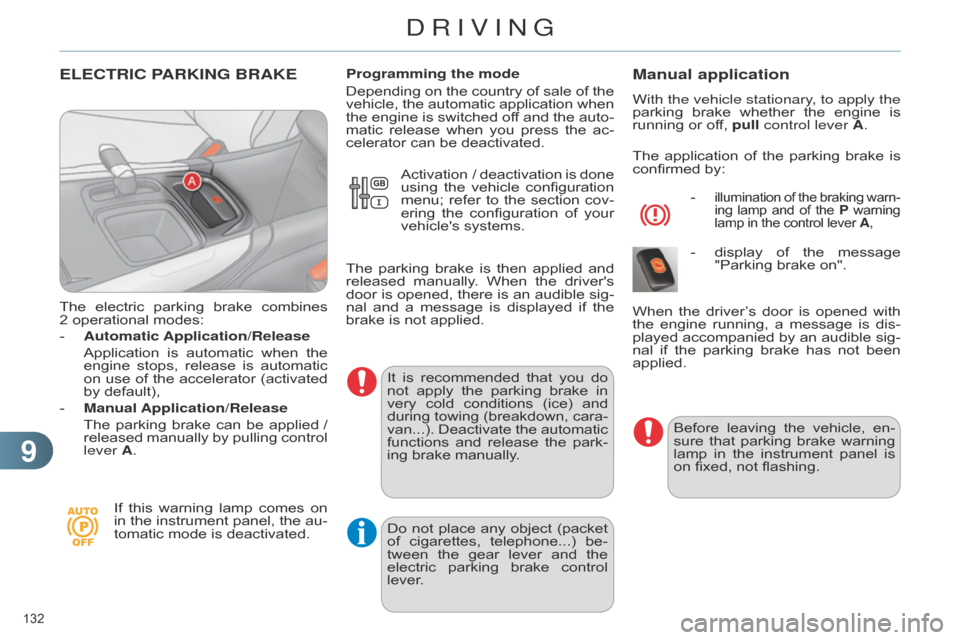
99
132
ELECTRIC PARKING BRAKE
The electric parking brake combines 2 operational
modes:
-
Automatic Application/Release
Application
is
automatic
when
the
engine
stops,
release
is
automatic
on
use
of
the
accelerator
(activated
by
default),
-
Manual Application/Release
The
parking
brake
can
be
applied
/
released
manually
by
pullin
g
control
lever
A.
If
this
warning
lamp
comes
on
in
the
instrument
panel,
the
au
-
tomatic
mode is deactivated.Programming the mode
Depending
on
the
country
of
sale
of
the
vehicle,
the
automatic
application
when
the
engine
is
switched
of
f
and
the
auto
-
matic
release
when
you
press
the
ac
-
celerator can be deactivated.
It
is
recommended
that
you
do
not
apply
the
parking
brake
in
very
cold
conditions
(ice)
and
during
towing
(breakdown,
cara
-
van...).
Deactivate
the
automatic
functions
and
release
the
park
-
ing
brake manually.
Manual application
With the vehicle stationary, to apply the
parking brake whether the engine is
running
or off, pull control lever A.
The
application
of
the
parking
brake
is
confirmed
by:
-
illumination of the braking warn -
ing lamp and of the P warning lamp
in the control lever A,
- display of the message "Parking
brake on".
Before
leaving
the
vehicle,
en
-
sure
that
parking
brake
warning
lamp
in
the
instrument
panel
is
on
fixed, not flashing.
When
the
driver
’s
door
is
opened
with
the
engine
running,
a
message
is
dis
-
played
accompanied
by
an
audible
sig
-
nal
if
the
parking
brake
has
not
been
applied.
Activation
/
deactivation
is
done
using
the
vehicle
configuration
menu;
refer
to
the
section
cov
-
ering
the
configuration
of
your
vehicle's
systems.
The
parking
brake
is
then
applied
and
released
manually
.
When
the
driver's
door
is
opened,
there
is
an
audible
sig
-
nal
and
a
message
is
displayed
if
the
brake
is
not
applied.
Do
not
place
any
object
(packet
of
cigarettes,
telephone...)
be
-
tween
the
gear
lever
and
the
electric
parking
brake
control
lever
.
DRIVING
Page 135 of 328
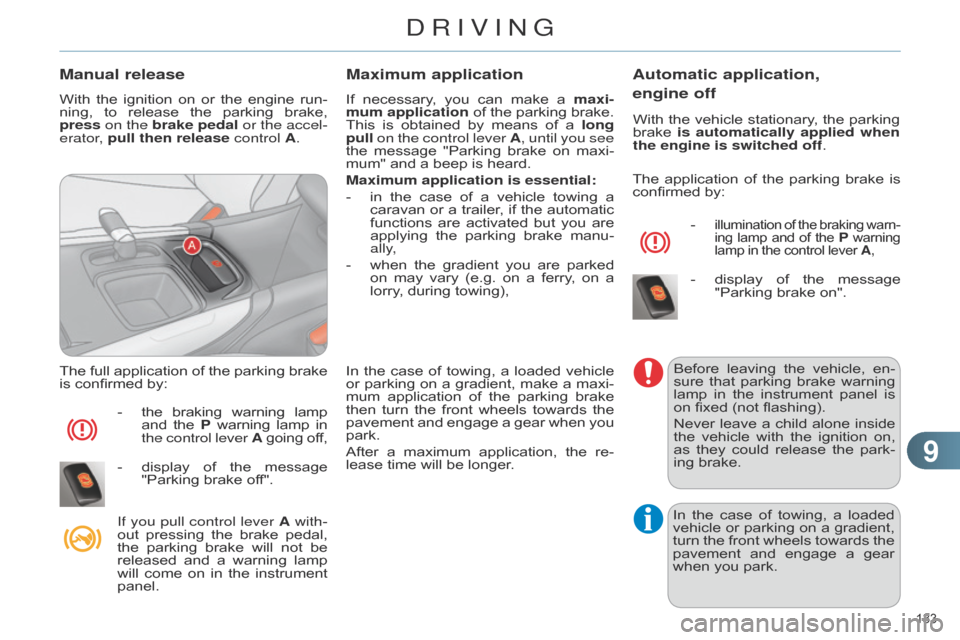
99
133
Manual release
With the ignition on or the engine run -
ning, to release the parking brake,
press
on the brake pedal or the accel-
erator, pull then release control A.
The
full
application
of
the
parking
brake
is
confirmed by:
-
the
braking
warning
lamp and
the
P warning
lamp
in the control lever
A
going
of
f,
-
display
of
the
message
"Parking
brake off".
If you pull control lever A with-
out
pressing
the
brake
pedal,
the
parking
brake
will
not
be
released
and
a
warning
lamp
will
come
on
in
the
instrument
panel.
Maximum application
If necessary, you can make a maxi -
mum application of the parking brake.
This
is
obtained
by
means
of
a
long
pull
on the control lever A, until you see
the
message
"Parking
brake
on
maxi
-
mum"
and a beep is heard.
Maximum application is essential:
-
in
the
case
of
a
vehicle
towing
a
caravan
or
a
trailer
,
if
the
automatic
functions
are
activated
but
you
are
applying
the
parking
brake
manu
-
ally,
-
when
the
gradient
you
are
parked
on
may
vary
(e.g.
on
a
ferry
,
on
a
lorry
, during towing),
In
the
case
of
towing,
a
loaded
vehicle
or
parking
on
a
gradient,
make
a
maxi
-
mum
application
of
the
parking
brake
then
turn
the
front
wheels
towards
the
pavement
and
engage
a
gear
when
you
park.
After
a
maximum
application,
the
re
-
lease
time will be longer.
Automatic application,
engine off
- illumination of the braking warn -
ing lamp and of the P warning lamp
in the control lever A,
- display of the message "Parking
brake on".
Before
leaving
the
vehicle,
en
-
sure
that
parking
brake
warning
lamp
in
the
instrument
panel
is
on
fixed (not flashing).
Never
leave
a
child
alone
inside
the
vehicle
with
the
ignition
on,
as
they
could
release
the
park
-
ing
brake.
In
the
case
of
towing,
a
loaded
vehicle
or
parking
on
a
gradient,
turn
the
front
wheels
towards
the
pavement
and
engage
a
gear
when
you park.
The
application
of
the
parking
brake
is
confirmed
by:
With
the
vehicle
stationary
,
the
parking
brake
is
automatically applied when
the engine is switched off.
DRIVING
Page 136 of 328
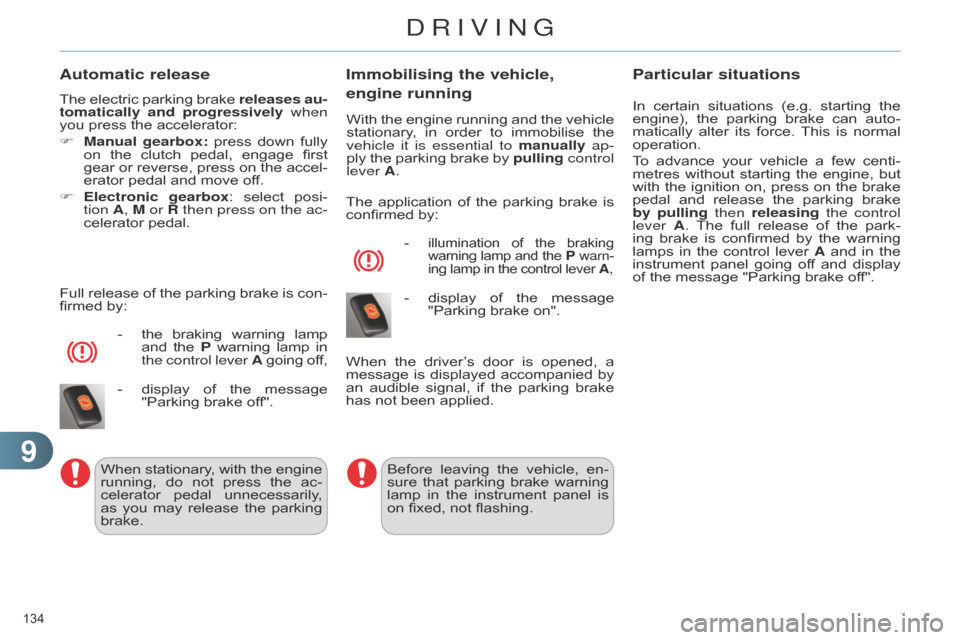
99
134
Automatic release
The electric parking brake releases au-
tomatically and progressively when
you
press the accelerator:
F
Manual gearbox:
press
down
fully
on
the
clutch
pedal,
engage
first
gear
or
reverse,
press
on
the
accel
-
erator
pedal and move off.
F
Electronic gearbox
:
select
posi
-
tion
A
, M or R then press on the ac-
celerator
pedal.
Full
release
of
the
parking
brake
is
con
-
firmed
by:-
the
braking
warning
lamp and
the
P warning
lamp
in the control lever
A
going
of
f,
-
display
of
the
message
"Parking
brake off".
When
stationary
,
with
the
engine
running,
do
not
press
the
ac
-
celerator
pedal
unnecessarily
,
as
you
may
release
the
parking
brake.
Immobilising the vehicle,
engine running
- illumination of the braking warning
lamp and the P
warn-
ing
lamp in the control lever A,
- display of the message "Parking
brake on".
Before
leaving
the
vehicle,
en
-
sure
that
parking
brake
warning
lamp
in
the
instrument
panel
is
on
fixed, not flashing.
Particular situations
In certain situations (e.g. starting the engine),
the parking brake can auto -
matically
alter
its
force.
This
is
normal
operation.
T
o
advance
your
vehicle
a
few
centi
-
metres
without
starting
the
engine,
but
with
the
ignition
on,
press
on
the
brake
pedal
and
release
the
parking
brake
by pulling
then releasing the control
lever
A
.
The
full
release
of
the
park
-
ing
brake
is
confirmed
by
the
warning
lamps
in
the
control
lever
A
and
in
the
instrument
panel
going
of
f
and
display
of
the message "Parking brake off".
When
the
driver
’s
door
is
opened,
a
message
is
displayed
accompanied
by
an
audible
signal,
if
the
parking
brake
has
not
been
applied.
The
application
of
the
parking
brake
is
confirmed
by:
With
the
engine
running
and
the
vehicle
stationary
,
in
order
to
immobilise
the
vehicle it is essential to
manually ap-
ply
the
parking
brake
by
pulling
control
lever A.
DRIVING
Page 139 of 328

99
137
SituationsConsequences
To apply the electric parking brake:
F
immobilise
the vehicle and switch off the ignition.
F
pull
the
control
for
at
least
5
seconds
or
until
application
is
complete.
F
switch
on
the
ignition
and
check
the
switching
on
of
the
electric
parking brake warning lamps.
The
application is slower than during normal operation.
To
release the electric parking brake:
F
switch
on the ignition.
F
pull
the
control
and
hold
it
for
approximately
3
seconds
then
release it.
If
the
braking
warning
lamp
is
flashing
or
if
the
warning
lamps
do
not
come
on
with
the
ignition
on,
these
procedures
will
not
work.
Place
the
vehicle
on
level
ground
and
have
it
checked
by a CITROËN dealer or a qualified workshop.
and
possibly
flashing
Display
of
the
message
"
Parking brake fault"
and
of
the
following
warning
lamps: -
Only
the
automatic
application
on
switching
of
f
the
en
-
gine
and
automatic
release
on
acceleration
functions
are
available.
-
The
manual
application/release
of
the
electric
parking
brake
and the emergency braking are not available.
and
possibly
flashing
Battery
fault: -
If
the
battery
warning
lamp
comes
on
you
must
stop
imme
-
diately
as
soon
as
the
traffic
allows.
Stop
and
immobilise your
vehicle
(if
necessary
,
place
the
two
chocks
under
the wheels).
-
Apply
the
electric
parking
brake
before
switching
of
f
the
engine.
DRIVING
Page 140 of 328
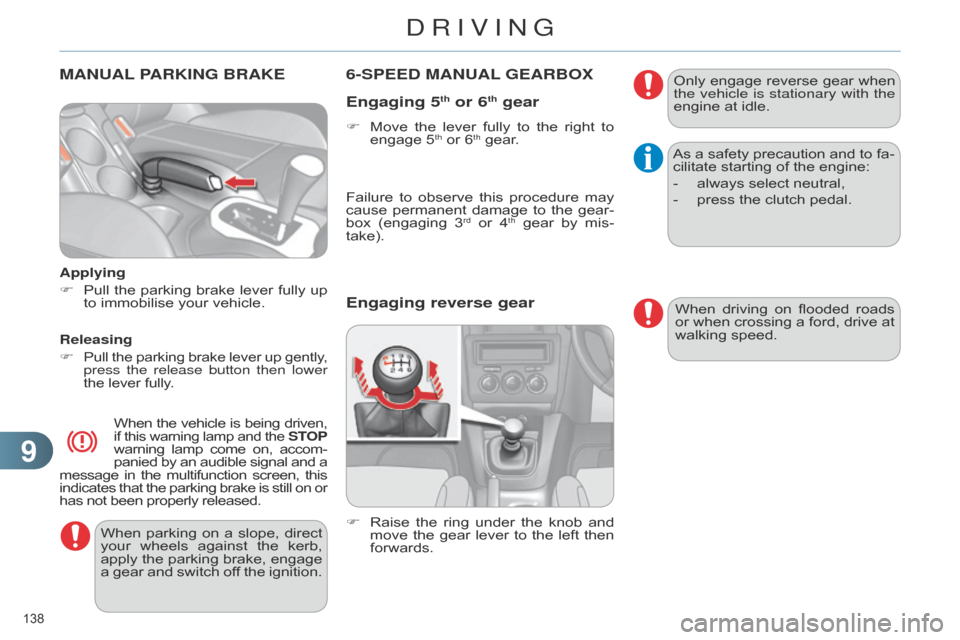
99
138
MANUAL PARKING BRAKE
Applying
F
Pull
the
parking
brake
lever
fully
up
to
immobilise your vehicle.
Releasing
F
Pull the parking brake lever up gently , press the release button then lower
the
lever fully.
When the vehicle is being driven, if this warning lamp and the ST OP warning lamp come on, accom -
panied by an audible signal and a message
in
the
multifunction
screen,
this indicates
that
the
parking
brake
is
still
on
or has
not
been properly released.
When parking on a slope, direct your
wheels against the kerb,
apply
the
parking
brake,
engage
a
gear
and
switch
of
f
the
ignition.
6-SPEED MANUAL GEARBOX
Engaging 5th or 6th gear
F Move the lever fully to the right to engage
5th or 6th gear. Only
engage
reverse
gear
when
the
vehicle is stationary with the
engine at idle.
As a safety precaution and to fa -
cilitate
starting of the engine:
-
always
select neutral,
-
press
the clutch pedal.
Engaging reverse gear
F Raise the ring under the knob and move
the gear lever to the left then
forwards.
Failure
to
observe
this
procedure
may
cause
permanent
damage
to
the
gear
-
box
(engaging
3rd or
4th gear by mis -
take).
When
driving
on
flooded
roads
or
when
crossing
a
ford,
drive
at
walking
speed.
DRIVING
Page 142 of 328

99
140
Displays in the instrument panel
Gear lever positions
N.
n eutral
R.
Reverse
1, 2, 3, 4, 5, 6.
Gears
in
sequential
mode.
AUT
O.
This
comes
on
when
the
au
-
tomated
mode
is
selected.
It
switches
of
f
on
changing
to
sequential
mode. You
must
press
the
brake
pedal
when
starting the engine.
F
Select position
N.
F
Press
the brake pedal down fully.
F
Start
the engine.
Moving off
F Select
automated mode (position A )
or sequential mode (position M ) or
reverse (position R).
F
Release
the
parking
brake
unless
it
is
programmed to automatic mode.
F
Progressively
take
your
foot
of
f
the
brake
pedal.
F
Accelerate
away.
Automated mode
F Select position A.
For
optimum
acceleration,
for
example
when
overtaking
another
vehicle,
press
the
accelerator
pedal
firmly
past
the
point
of resistance.
Engagement
of
reverse
gear
is
accompanied
by
an
audible
signal. If
the
engine
does
not
start:
-
If
N
is
flashing
in
the
instru
-
ment
panel,
move
the
gear
lever to position
A, then to
position N. AUTO
and
1
,
1 or R appear in the in-
strument panel screen.
The
gearbox
operates
in
auto-active
mode,
without
any
action
on
the
part
of
the
driver
.
It
continuously
selects
the
most
suitable gear for:
-
optimisation
of fuel consumption,
-
the
style of driving,
-
the
profile of the road.
-
the
vehicle load.
N
appears
in
the
instrument
panel
screen.
-
If
the
"Foot on
brake"
warning
lamp
comes
on,
accom
-
panied
by
an
audible
signal
and
the
display
of
a
message,
press
the
brake
pedal
firmly
.
n
ever select neutral N when
driving. AUTO
and
the
gear
engaged
appear
in
the
instrument
pan
-
el
screen.
DRIVING
Page 143 of 328

99
141
You can change mode at any time
by moving the gear lever
from
A
to M or the other way
round.
At
low
high
speed,
if
reverse
gear
is
requested,
the
N
indicator
flashes
and
the
gearbox
goes
into
neutral
automati
-
cally.
T
o
engage
reverse,
put
the
gear
lever in position
N, then position R. When
immobilising the vehicle, with
the engine running, you
must
place
the
gear
lever
in
neu
-
tral N.
Before
carrying
out
any
work
in
the
engine
compartment,
ensure
that
the
gear
lever
is
in
neutral N
and
that
the
parking
brake
is
ap
-
plied.
Whatever
the
circumstances,
you
must
manually
apply
the
parking
brake
when
parking,
unless
the
parking
brake
is
pro
-
grammed
in automatic mode.
Reverse
To engage reverse gear R , the vehicle
must be immobilised with your foot on
the
brake pedal.
F
Select position
R.
Operating fault
With the ignition on, the flashing of AUT
O, accompanied by an audible sig -
nal
and
a
message
in
the
screen,
indi
-
cates
a malfunction of the gearbox.
Have
it
checked
by
a
CITROËN
dealer
or
a qualified workshop.
Manual mode
F Select position M.
The
gears
engaged
appear
in
succession
in
the
instrument
panel
screen.
The
gear
change
requests
are
only
act
-
ed
on if the engine speed permits.
It is not necessary to release the accel-
erator
during gear changes.
When
braking
or
slowing
down,
the
gearbox
changes
down
automatically
to allow the vehicle to accelerate in the
correct
gear.
On
sharp
acceleration,
the
gearbox
will
not
change
up
unless
the
driver
acts
on
the
gear
lever
or
the
steering
mounted
paddles. T
emporary control of gear changing
You
can
temporarily
take
over
control
of
gear
changing
using
the
"+"
and
"-"
steering
mounted
paddles:
if
the
engine
speed
allows,
the
request
to
change
gear
is acted on.
This function allows you to anticipate
certain
situations
such
as
overtaking
a
vehicle
or the approach to a corner.
After
a
few
moments
without
any
action
on
the
control
paddles,
the
gearbox
re
-
sumes automatic control of the gears.
n
ever select neutral N while the
vehicle is moving.
Stopping the vehicle
Before switching
of f the engine, you can:
-
move
to
position
N
to
engage
neu
-
tral,
or
-
leave
the
gear
engaged;
in
this
case,
it
will
not
be
possible
to
move
the
vehicle.
In both cases, you must apply the
parking brake
to
immobilise
the
ve
-
hicle.
DRIVING